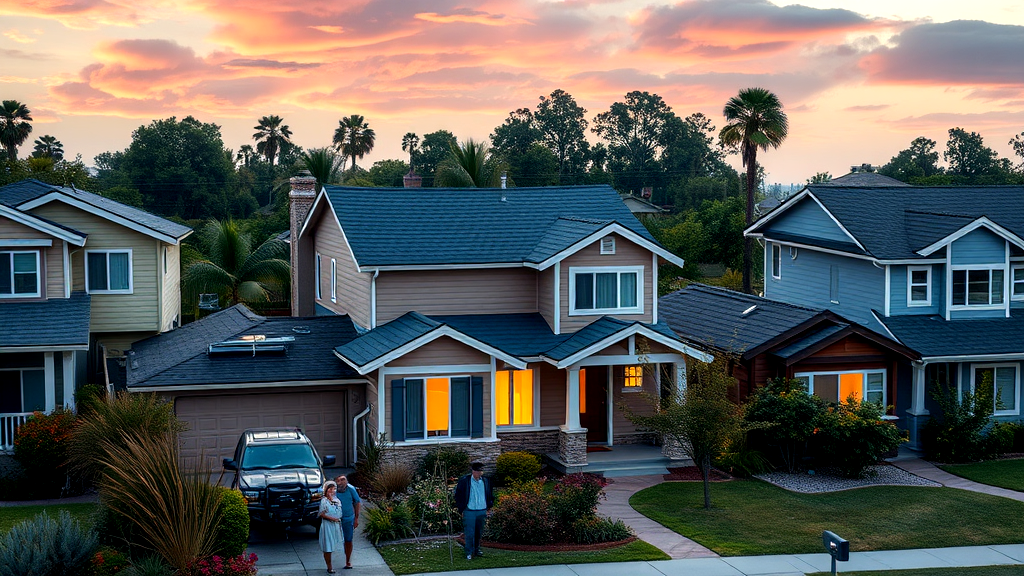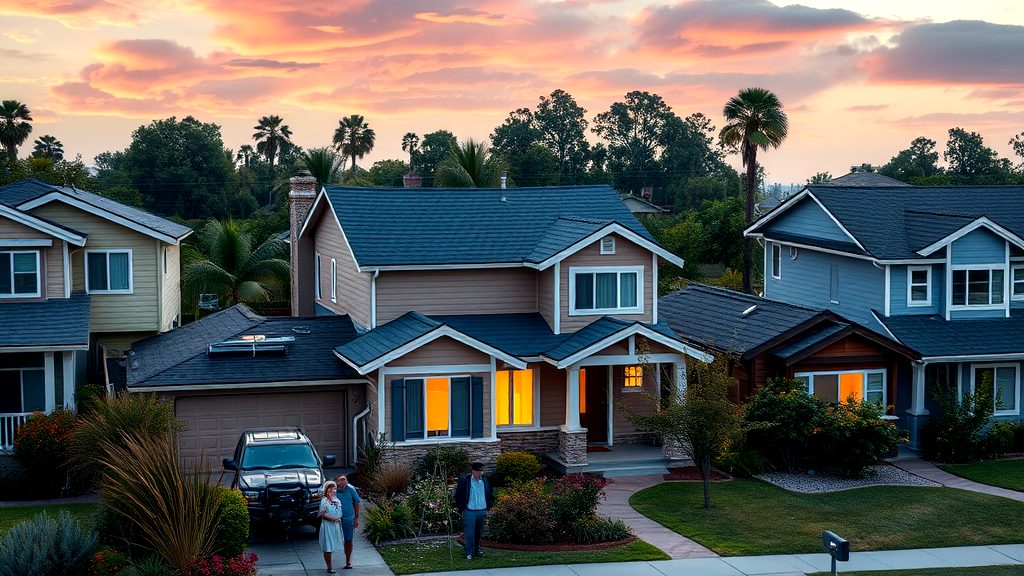Rising Insurance Costs: Economic Fallout
Homeowners are feeling the pinch as insurance costs soar. Climate change, tariffs, and extreme weather drive this rise. By 2025, premiums could jump 8% nationally. Some states might see even more. Rebuilding is pricier, thanks to higher material costs and tariffs on steel, aluminum, and lumber. This situation has insurers handing over the bill to consumers. Meanwhile, the National Energy Dominance Council promotes fossil fuel projects, impacting policies. Supreme Court rulings add to the environmental risks. In Germany, courts are holding companies liable for climate damages. Such changes could influence policies worldwide. Homeowners in states like California and Florida face soaring insurance rates. These insurance rates amid current events present a growing challenge.
Key Takeaways
-
Homeowners face soaring insurance costs due to rising material prices and tariffs.
-
Climate change increases extreme weather, impacting claims and insurance pricing.
-
States like California and Florida send home insurance premiums skyrocketing due to disasters.
-
Supreme Court rulings and fossil fuel projects influence environmental risks and costs.
-
Recent German court decisions may affect global insurance policies.

Factors Driving Soaring Insurance Rates
The factors that drive insurance costs soaring are many and complex. Material prices have skyrocketed, partly due to tariffs on key construction items like steel and aluminum. Insurers, in turn, pass these rising costs directly onto policyholders. Climate change plays a crucial role too. It’s not just a buzzword; it affects everyone. With more extreme weather events, the number of claims has surged, pressuring insurers to adjust their pricing.
Then there’s the Supreme Court. Recent decisions have allowed more fossil fuel infrastructure, raising environmental concerns. The risk of climate disasters increases, further driving up costs. The National Energy Dominance Council and their policies focus heavily on fossil fuels, which might not be the best long-term strategy for stabilizing insurance rates. Lastly, rulings like those from the German court around corporate liability for climate damages could set a global precedent as seen here. This ripple effect could impact everyone.
Climate Change and Its Role
The ripple effects of climate change on rising insurance costs are becoming hard to ignore. As extreme weather events grow more frequent, insurers scramble to adjust pricing models. This results in homeowners feeling the pinch in their wallets. It’s like a financial storm brewing, and there’s no easy way out. The National Energy Dominance Council prioritizes traditional energy sources, which can amplify climate-related risks. This, in turn, creates a cycle of increasing premiums.
On the legal front, a German court ruling has acknowledged corporate liability for climate damages. This could set a new precedent in how future insurance policies are crafted. The Supreme Court decisions have also impacted environmental oversight, potentially worsening climate risks. With these dynamics in play, the prospect of face soaring insurance costs appears grim. Tackling this issue calls for innovative approaches and a shift toward more sustainable energy practices.
Impact on Homeowners Across Regions
Rising insurance costs are hitting homeowners differently depending on their location. Regions like California and Florida are feeling the heat, thanks to wildfires and hurricanes ramping up the pressure on premiums. Florida, in particular, is bracing for a hefty $15,460 annual insurance bill. Yikes! This financial burden isn’t just a result of Mother Nature’s fury. The Energy Dominance Council has also played its part, with its focus on fossil fuel infrastructure influencing policy shifts that prioritize these projects over renewables. This has environmental implications, nudging insurance premiums upwards.
Homeowners across these regions have to navigate this rocky terrain. Those in the eye of the storm are considering ways to lessen the blow. For instance, weather-resistant upgrades can be a game-changer. By investing in smart home technologies, which I’ve discussed in my blog about building a smart home, homeowners can better prepare for the unexpected, potentially easing the weight of rising costs.

National Energy Dominance and Costs
The influence of the Energy Dominance Council on fossil fuel policies has been significant. This body has focused on expanding fossil fuel infrastructure, which leads to unintended impacts on rising insurance costs. These projects often overshadow renewable energy initiatives, which could mitigate some environmental risks.
The ongoing emphasis on fossil fuels creates a domino effect of sorts. Increased infrastructure can heighten environmental risks, potentially escalating the frequency of climate-related disasters. This, in turn, nudges insurance premiums upward.
With climate change already complicating insurance calculations, such energy decisions add fuel to the fire. They amplify the challenges insurers face in adjusting their pricing models.
This strategic focus on fossil fuels may seem like a short-term gain but could result in long-term financial pain for homeowners. For more insights on related reforms, the VA home loan reform I discussed earlier ties into broader economic concerns.
The Influence of Fossil Fuel Infrastructure
The sway of infrastructure related to fossil fuels is a hot topic lately. Recent decisions emphasize this infrastructure, potentially increasing environmental risks. This could worsen climate change impacts, nudging insurance premiums up. And who wouldn’t feel the pinch in their wallet?
This focus shifts energy policies, often favoring fossil projects over renewables. The Energy Dominance Council plays a part here. Their decisions may link to higher insurance costs due to increased climate risks. Yikes, right?
In regions susceptible to disasters, these shifts could spell disaster for homeowners. That’s why some are turning to affordability assistance programs. In my recent piece on California’s programs, I touched on how these changes are affecting insurance. It’s worth a read if you’re curious about local impacts.
Climate change’s role in this saga can’t go unnoticed. With insurers adjusting their models, the financial burden could keep climbing.
Supreme Court Decisions Affecting Policies
Court rulings impacting policies can lead to changes that affect rising insurance costs. Recent judicial decisions have modified how environmental reviews are conducted, directly affecting project approvals. This can lead to more frequent industrial developments, potentially increasing environmental risks.
When projects that may worsen environmental conditions get green-lighted, insurers often need to rethink their risk assessments. These changes could mean higher premiums for consumers. For instance, rulings that prioritize industrial growth over environmental concerns can make natural disasters more common. This, in turn, leads to more claims and rising rates.
In a related scenario, a German court recently set a precedent by recognizing corporate responsibility for environmental damage. This could ripple across the insurance world, influencing future policies. As discussed in a piece on Peruvian farmers’ lawsuit, such legal shifts may affect corporate strategies and insurance calculations. More about this can be found here.

German Court Rulings on Liabilities
The rulings on liabilities in Germany have stirred up quite the storm, especially for those keeping an eye on rising insurance costs. When courts in Germany acknowledged corporate liability for environmental harm, it sent ripples through the insurance world. This could mean a new chapter in global insurance policies. Companies may now face more lawsuits for environmental damage, prompting insurers to adjust their policies accordingly. This trickle-down effect might just hit the pockets of regular folks through increased premiums.
Such legal acknowledgments add another layer to the ongoing puzzle of insurance pricing. As insurers anticipate potential liabilities, they might factor in the costs of defending against environmental claims or paying for damages. This could lead to higher premiums, impacting both businesses and individuals. While these shifts are complex, they highlight the delicate dance between law, liability, and the evolving insurance market.
Extreme Weather Events’ Contribution
Extreme weather events have a knack for making insurance premiums skyrocket. Wildfires, hurricanes, and other natural disasters are leaving insurers and homeowners in a financial pickle. The frequency and severity of these events have grown, creating a cascade of claims that insurers have to juggle. As insurers try to stay afloat, they pass the buck to the policyholders.
This means folks might see a shocking increase when their renewal notice arrives. For instance, states like California and Florida are bearing the brunt, thanks to their fiery and stormy guests. The ripple effect of these events is felt nationally, with premiums climbing to new heights.
So, what’s a homeowner to do? Well, it’s time to get crafty. Consider fortifying your castle with weather-resistant upgrades. Shop around for better quotes, and think about bundling policies. These small steps can help dodge the full impact of those pesky rising insurance costs.
Energy Policy Shifts and Insurance Costs
The evolving energy policies emphasizing traditional energy sources are stirring the pot for insurance premiums. By prioritizing these energy projects, there’s a ripple effect on climate risk, which ultimately impacts insurance prices. As these risks grow, so do the rising insurance costs. This isn’t just about numbers on a page; it’s about real-world consequences for policyholders everywhere.
For example, the shift in focus to these energy projects has been linked to potential increases in climate-related incidents. These events, in turn, lead to more claims and higher premiums. It’s like a domino effect, where one change leads to another, impacting homeowners’ wallets.
With all these changes, insurance providers find themselves in a tight spot. They need to adjust their pricing models to stay afloat. This means the burden often shifts to the consumer, who might feel like they’re stuck between a rock and a hard place.

Top 5 States with Highest Increases
When discussing the states experiencing the most significant hikes due to rising insurance costs, certain regions stand out. Louisiana is grappling with unprecedented increases, largely due to frequent hurricanes. This state finds itself in hot water, leaving homeowners in a pickle. California is battling wildfires, causing insurance costs to skyrocket. It’s a double-edged sword, as safety measures often come with a hefty price tag.
Florida remains a top contender with its hurricane woes. It’s like Mother Nature’s playground there, and residents pay the price. Texas, with its vast size, faces diverse risks from storms to fires, making insurance a tricky business. Lastly, New York isn’t far behind, with rising costs driven by urban vulnerabilities.
-
Louisiana
-
California
-
Florida
-
Texas
-
New York
These states illustrate how nature’s fury and urban challenges play roles in insurance costs.
Future Predictions for Insurance Trends
Future predictions indicate a storm brewing in the insurance sector. Insurance premiums continue their uphill climb, driven by unpredictable weather and material costs. Homeowners might feel like they’re stuck in a financial whirlwind, especially in states prone to nature’s wrath.
It’s a bit like watching prices rise on a roller coaster with no brakes. The rise in home rebuilding expenses, thanks to tariffs and material shortages, has insurers adjusting their strategies. This domino effect has left many consumers scratching their heads and wallets.
The ripple effect of decisions allowing more infrastructure projects looms large. It’s akin to adding fuel to a fire, potentially sparking more claims. Alongside, international court rulings on corporate responsibility could pave new paths in global insurance landscapes.
As insurers brace for these shifts, homeowners are left strategizing. To weather the storm, they might compare quotes or bundle policies, creating some financial breathing room.
Strategies for Homeowners to Mitigate Costs
When looking to ease the burden of mounting premiums, consider exploring various ways to reduce expenses. Start by shopping around. Different insurers offer unique rates and discounts. Bundle your policies, like auto and home, for potential savings. This could lighten the load on your wallet.
Raise your deductible to lower premiums. It’s a gamble but can save you some cash in the long run. Don’t forget about home upgrades! Invest in weatherproofing your home. Storm shutters or reinforced roofs can make a big difference.
Even simple steps, like clearing gutters, could help. Stay informed about available discounts for being claim-free or installing security systems. It might seem like a small savings, but every penny counts when combating those steep premiums.
Lastly, stay proactive. Regularly review and update your coverage to ensure it meets your needs without overpaying.
Conclusion
As insurance rates climb, homeowners are feeling the pinch. Imagine watching your bills skyrocket while worrying about the next storm. It’s a real gut-punch, isn’t it? The challenge is figuring out how to keep your home protected without emptying your wallet.
Homeowners can take action, though. Ever tried bundling your policies? It’s like a two-for-one deal at the supermarket. It could save you a few bucks. Or consider weather-resistant upgrades. Think of it as armor for your house.
Above all, stay informed. Knowledge is power, and a little research goes a long way. Keep an eye on trends and predictions. You’ll be better equipped to navigate these choppy waters. It’s like sailing a ship through a storm; preparation makes all the difference.
FAQ
-
Why are insurance costs rising so quickly?
Insurance costs are skyrocketing because of several factors. Material prices have jumped, making rebuilding pricey. Climate change is stirring up more extreme weather, leading to more claims. Insurers are adjusting premiums to stay afloat. It’s like a perfect storm for your wallet.
-
How does climate change affect my insurance premiums?
Climate change increases the number and severity of weather events like hurricanes and wildfires. These events cause more damage, which means more claims. Insurers then raise rates to cover these increasing costs. It’s like nature’s way of reminding us who’s boss.
-
Which states are seeing the biggest hikes in insurance costs?
States like Florida, California, and Louisiana are getting hit the hardest. These areas face frequent and severe weather events, driving up claims and premiums. If you’re in one of these states, brace yourself for sticker shock.
-
How can I lower my insurance premiums?
You can lower your premiums by shopping around and comparing quotes. Bundling your home and auto insurance can also help. Consider raising your deductible, but do so with caution. Making your home more weather-resistant can earn you discounts too.
-
What role do energy policies play in insurance costs?
Energy policies that favor fossil fuels over renewables can increase climate risks. This may lead to more extreme weather and, in turn, more insurance claims. It’s like paying the price for our energy choices.


 Facebook
Facebook
 X
X
 Pinterest
Pinterest
 Copy Link
Copy Link




